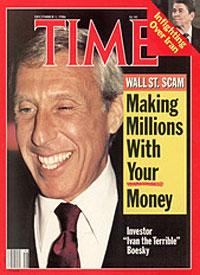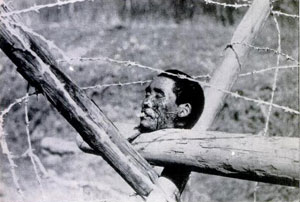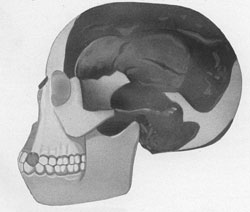This week in history: December 17 - December 23
17 December 2012
This Week in History provides brief synopses of important historical events whose anniversaries fall this week.
25 Years Ago | 50 Years Ago | 75 Years Ago | 100 Years Ago
25 years ago: Wall Street insider trader sentenced to prison
 Boesky on Time's cover
Boesky on Time's coverIvan Boesky, 50 years old and one of Wall Street’s most successful speculators, was sentenced to three years in prison on December 18, 1987 for conspiring to file false stock trading records. Boesky was the center of a massive insider trading operation, illegally manipulating stock prices, conducting unlawful corporate takeovers and using false bookkeeping to cover up for his crimes.
As part of a plea bargain agreement, Boesky pled guilty to the criminal charge, and cooperated with the prosecutors in uncovering the scope of his crimes. A year before, Boesky had settled insider-trader charges by paying a $100 million dollar fine, without being required to admit guilt for any criminal activity. In the December 1987 hearing, US District Judge Morris Lasker did not impose any fine on Boesky, because he said he wanted to have Boesky’s funds available for lawsuits by victimized clients.
On the decision to sentence Boesky to prison—an extraordinary occurrence in the financial sector—Lasker stated, “Breaking the law is breaking the law. Some kind of message must be sent to the business community that such activities cannot be wholly repaired simply by repaying people after the fact ... Ivan Boesky is not only guilty of simple insider trading, but the scope of his offenses is substantially enlarged, as he himself concedes, by engaging in many transactions at the behest of others on a scale so substantial as to represent a systemic problem in the financial market.”
Boesky’s testimony implicated at least five major brokerage firms and more than 14 individuals for violations of the securities laws. Boesky is credited for the quotation from fictional character Gordon Gekko, “Greed is good,” in Oliver Stone’s 1987 film, Wall Street. The quotation was paraphrased from a speech Boesky made in 1986 at the University of California at Berkeley.
Boesky ended up serving only two years of the 3-year sentence at Lompoc Federal Prison but was barred for the rest of his life from the securities business.
50 years ago: Juan Bosch elected president of the Dominican Republic
 Bosch with US President Kennedy
Bosch with US President KennedyThe first free elections in the history of the Dominican Republic, held December 20, 1962, resulted in the election of the left bourgeois nationalist Juan Bosch, of the Dominican Revolutionary Party, and his running mate, Armando González Tamayo, who defeated Viriato Fiallo of the National Civic Union by a margin of two to one.
Bosch, then 53, was a long-time political exile and one of the most prominent literary figures in the country’s history. He was jailed shortly after Rafael Trujillo seized power in 1934, and left the country after he was released from prison, remaining abroad for more than 23 years, living mainly in Puerto Rico and Cuba.
He won several literary prizes, while continuing political activity, which culminated in a failed attempt to overthrow Trujillo in 1949. The Dominican military suppressed the uprising sparked by a landing at Cayo Confites on the north coast of the country, and Bosch fled into exile again, this time to Venezuela and then Cuba. In 1952, after the right-wing coup by Fulgencio Batista in Cuba, Bosch was jailed again, before going into exile in Costa Rica.
The 1959 Cuban Revolution marked the beginning of the end for the Trujillo dictatorship, and the new Kennedy administration in the United States, which took office in January 1961, concluded that the old regime was too vulnerable to popular overthrow. Just a month after the failure of the Bay of Pigs invasion of Cuba, on May 30, 1961, Trujillo was assassinated. Bosch returned to the country and revived the PRD in preparation for expected elections.
Bosch’s electoral victory was short lived, however. He was sworn in as president two months later, but overthrown in a military coup in September 1963. Another coup in April 1965, by pro-Bosch officers, triggered the invasion and occupation of the country by 42,000 American troops, ordered by US president Lyndon Johnson.
75 years ago: “Rape of Nanking” by Japanese army horrifies world opinion
 Nanking massacre
Nanking massacreThe first reports of the mass slaughter of Chinese residents of the city of Nanking by invading Japanese forces reached the world December 18, 1937, with reports in newspapers like the Times of London of the atrocities that had taken place five days before.
The Times reported eyewitness accounts under the headline “Terror in Nanking”. The newspapers correspondent reported how chaos reigned as the city burned furiously during the final hours of defence by Chinese forces as Japanese artillery bombarded the city. Witnesses told the Times correspondent of the deafening noise created by combat and bombardment.
In the final remaining hours of the Chinese rear-guard action, whole divisions of the defending army, with defeat looming, abandoned their positions under threat of being overrun and began streaming towards the city’s River Gate. The Hsiakwan riverfront was the only exit from the city as Japanese troops entered the city and headed northward. But upon finding that no vessels remained to ferry troops across the river to the relative safety of the opposite bank, troops fell into blind panic, abandoning their arms and uniforms as they sought sanctuary. An official retreat was sounded but this was soon transformed into a rout as Japanese troops began to overrun central Nanking.
During their retreat, Chinese troops set fire to the Ministry of Communications, considered the most ornate building in the city, after filling it with explosives. The thunderous blast created pandemonium among Nanking residents and the resulting traffic jams added to a general air of panic.
Chinese troops and civilians gathered the next day in the so-called ‘Safety Zone, but when Japanese troops arrived, noted the Times, “The Chinese fled in terror, and the horror of the scene was accentuated by the wounded who were crawling around imploring aid.” As the Japanese soldiers began searching the “Safety Zone,” anyone caught out of doors without good reason was summarily shot dead on the spot. Atrocities would continue until February the next year.
100 years ago: Fake Piltdown man unveiled
 Piltdown skull reconstruction
Piltdown skull reconstructionOn December 18, 1912, one of the most notorious of scientific hoaxes began. Charles Dawson, an amateur archeologist, claimed that four years earlier he had been given a fragment of a skull by a worker who discovered it at the Piltdown gravel pit. Dawson said that he had discovered other fragments, over the course of an intense search in 1912.
Dawson’s “discovery”, first outlined at a meeting of the Geological Society of London, ignited immense interest as it was purportedly an example of a previously unknown humanoid species. Arthur Smith Woodward, Dawson’s archeological partner, claimed at the meeting that the find, which appeared to combine a simian jaw structure with a human skull, represented a missing link in the chain of evolutionary development.
It was not until 1953 that it was definitively established that “Piltdown man”, as the find was dubbed, had been concocted from the jawbone of an orangutan, a human skull, and the fossilised teeth of a chimpanzee.
Piltdown man played a significant role in confusing scientific efforts to reconstruct human evolution. As a result of the hoax, scientists thought that the human brain expanded to a modern size before the jaw evolved in line with new dietary patterns. Archeological finds from South Africa which contradicted this misconception were ignored by many, particularly Anglo-Saxon, evolutionary biologists.
Prior to the definitive unmasking of Piltdown man as a hoax, a number of scientists expressed skepticism about the authenticity of the find. The resistance of the British scientific establishment was bound up the nationalist sentiment that Piltdown man established an evolutionary path located in Britain, not Africa or elsewhere. The identity of the hoaxer has never been established, though many possible hypotheses have been advanced.





Follow the WSWS